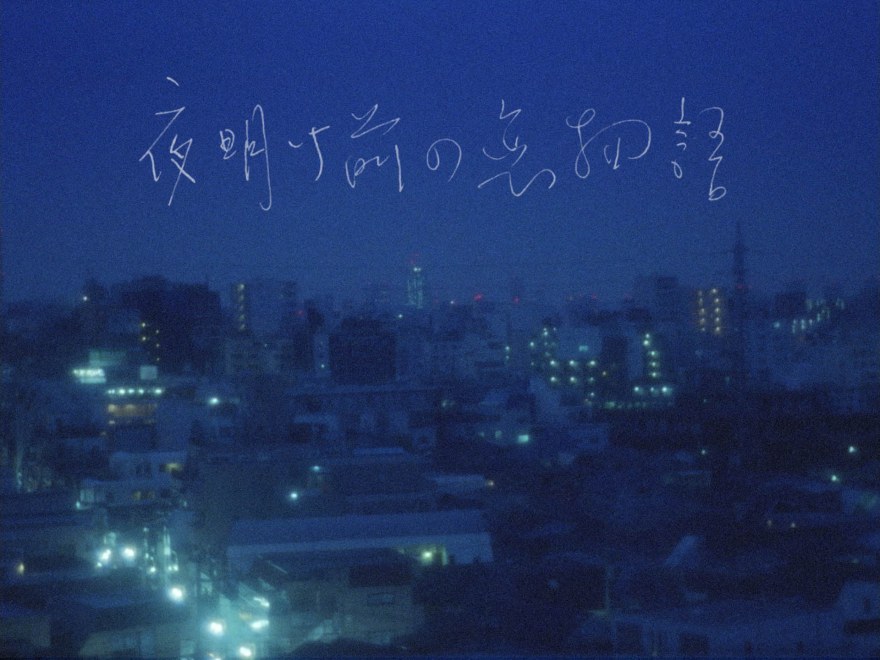Tea time with Yoakemae no KoiMonogatari [Before the Dawn]
Interview with Chunni Lin and Pang-Chuan Huang, codirectors of Yoakemae no KoiMonogatari [Before the Dawn]
How did you know about Weng-Nao’s work? Why did you want to try to track him down?
We first knew Weng-Nao’s work from a book, published in 2011, seventy years after his death; it was the first time all of his works were translated from Japanese to Mandarin (his original works were published in a literature magazine in his time, in Japanese). His works present a very special atmosphere of the time and his personal feelings towards life, and we don’t know how he spent the rest of his life in a foreign land, Japan. So we decided to go to the place where he last lived and wrote all his works.
Can you explain the name Eng-Do / Ong-Do?
In Japanese and Mandarin, we use some same characters in writing, but different pronunciation. In this case, Eng-Do written 遠藤, Ong-Do written 翁鬧, they sound similar in Japanese pronunciation but they are totally different characters. The man in the film is misled by the Japanese pronunciation. By the way Ong-Do(翁鬧)is pronounced Weng-Nao in Mandarin, so theoretically Weng-Nao is the correct pronunciation of his name, and that’s why he is called Weng-Nao in the synopsis.
Which material did you use to shoot?
16mm films, some of them were expired.
How long were you in Tokyo and how long did you shoot there?
We have made several trips to Tokyo, Japan, since 2016. In 2019, we started the shoot, we were there for two months from March 29th to May 2nd, meeting and interviewing people, and we documented the whole journey.
Can we say the most important is not the destination but the journey?
Yes indeed, many people expect a destination like they expect a clear ending or a goal in a film, but there is no such thing in our lives.
What is the nursery rhyme we can hear in the film and what was you interest in it?
It’s called “Gun-Kan Janken” (Battleship, paper, scissors, stone), it’s a traditional hand game that was popular during the War. In this game, Battleship indicates Stone; Korea indicates Scissors and Hawaii indicates Paper. The content of the game is quite horrifying, this hand game was being pointed out by many critics as not proper in modern Japanese society, but it is still very popular between children, and there are many different versions in different regions. We recorded this by chance when we walked down the main road of Koenji, three children were playing it loudly.
Tell us more about the poem you chose for the ending: when was it written, why did you want to share this one in the film? How is it linked to Taiwanese poetry?
The poem is entitled The Song of Bird, written in 1935. The bird could represent the image of this writer, who came from a colonised society, was forced to speak a language that was not his mother tongue, struggling so hard to survive in this metropolis, Tokyo. It could also represent Taiwanese writers in same period.
The poem structure with a chorus of animal sounds is similar to Ainu poetry, is there any link?
There is probably no connection between Ainu and Weng-Nao’s poetry. It was closer to the surrealist literature, which was taken from France to Japan in 1928, and instantly became a fancy trend in Japan and Taiwan. In the same period as futurism, Dadaism, surrealism, etc.
Would you say that the short film format has given you any particular freedom?
No doubt, short film is freedom!
What are your reference works?
Our primary reference is a film by Wim Wenders, Tokyo-Ga. It’s a documentary about the greatest Japanese filmmaker, Ozu Yasujiro. The director captured a society without any trace of Ozu, it seemed that the city of Tokyo had already left Ozu behind.
Yoakemae no KoiMonogatari [Before the Dawn] is part of Lab Competition L3.








